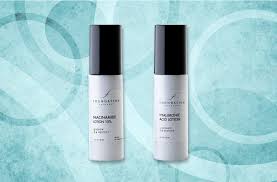
Can I Use Hyaluronic Acid and Niacinamide Together? Here’s Everything You Need to Know
When it comes to skincare staples, two ingredients consistently stand out as true heroes: hyaluronic acid and niacinamide.
These powerhouse ingredients are celebrated for their ability to hydrate, soothe, and improve the appearance of the skin. But a question that often arises is—can they be used together?
In this blog post, we’ll explore this popular skincare combination, break down what each ingredient does, and provide you with expert tips on how to use them both in your daily routine for the best results.
What is Niacinamide?
Niacinamide, also known as vitamin B3, is a water-soluble vitamin that plays a key role in maintaining healthy skin.
It’s loved for its ability to support the skin barrier, reduce inflammation, regulate oil production, and fade pigmentation. Niacinamide is one of the most versatile and well-tolerated ingredients available.
Key Benefits of Niacinamide:
Hydrates the skin: It works as a humectant, helping to draw moisture into the skin and hold it there.
Regulates oil production: Ideal for oily or acne-prone skin, it helps control excess sebum.
Reduces redness and blotchiness: Calms irritated skin and improves uneven tone.
Improves skin barrier function: Strengthens the outer layer of skin, protecting against environmental aggressors.
Fades dark spots: Helps reduce hyperpigmentation and acne marks over time.
Minimizes pore appearance: Makes pores appear smaller and skin look smoother.
Niacinamide is suitable for all skin types and is particularly helpful for people dealing with sensitivity, dryness, or breakouts.
What is Hyaluronic Acid?
Hyaluronic acid (HA) is a naturally occurring substance in the body that retains moisture. It’s known for its incredible hydrating abilities—holding up to 1,000 times its weight in water.
Used in skincare, hyaluronic acid draws moisture from the environment and deeper layers of skin to the surface, leaving the skin plump, hydrated, and supple.
Key Benefits of Hyaluronic Acid:
Deep hydration: It draws moisture into the skin, keeping it soft and bouncy.
Strengthens skin barrier: A well-hydrated barrier is better able to protect against environmental damage.
Reduces fine lines: Hydrated skin appears smoother and more youthful.
Improves skin texture: Helps create a smooth, glowing complexion.
Suitable for all skin types: Especially beneficial for dry, dehydrated, or mature skin.
Soothes irritated skin: Helps calm redness caused by dryness or environmental stress.
HA is commonly found in serums, moisturizers, and even cleansers, and it works well alongside a variety of other ingredients.
Can You Use Hyaluronic Acid and Niacinamide Together?
Yes, absolutely! Hyaluronic acid and niacinamide are two of the most compatible ingredients in skincare.
When used together, they can amplify each other’s benefits, leading to deeply hydrated, calm, and balanced skin.
Why They Work So Well Together:
Both are water-based, so they layer well without causing product separation or pilling.
HA boosts hydration, which helps niacinamide absorb more efficiently.
Niacinamide strengthens the skin barrier, locking in the moisture brought by HA.
The combination improves the skin’s texture, reduces redness, and enhances overall radiance.
How to Use Hyaluronic Acid and Niacinamide Together
Here’s how to combine these two skincare heroes effectively in your daily routine.
Option 1: Layering in the Same Routine
Start with clean, damp skin.
After cleansing, lightly pat your skin dry but leave it slightly damp. This helps hyaluronic acid perform better.
Apply hyaluronic acid first.
Use a serum or essence containing HA and gently pat it into your skin. This draws water into the skin and preps it for the next step.
Follow with niacinamide.
Apply a niacinamide serum or moisturizer. It will lock in the moisture and help reduce excess oil and redness.
Finish with moisturizer and SPF (if daytime).
Use a nourishing moisturizer to seal everything in, and always wear sunscreen during the day.
Option 2: Use in Different Routines
Morning: Apply hyaluronic acid to hydrate and protect the barrier for the day ahead.
Evening: Apply niacinamide to repair the skin and target oiliness, blemishes, and pigmentation while you sleep.
This method is ideal if your products are highly concentrated or if you’re easing into a new routine.
Do You Use Niacinamide Before or After Hyaluronic Acid?
It’s usually best to apply hyaluronic acid first, especially if it’s in a thinner serum. Then apply niacinamide after.
A general rule of thumb: apply skincare from thinnest to thickest consistency. So, if your niacinamide serum is thicker than your hyaluronic acid serum, apply HA first.
Can I Use Niacinamide Every Day?
Yes, you can use niacinamide daily—and many people use it twice a day without irritation.
It’s known for being gentle, even for sensitive skin, and it helps your skin maintain hydration, balance oil production, and reduce inflammation over time.
Niacinamide is especially useful in the winter months, when skin is prone to dryness from cold weather and indoor heating. It helps restore hydration and prevent barrier damage.
Can I Use Hyaluronic Acid Every Day?
Absolutely. In fact, hyaluronic acid is most effective when used consistently, ideally twice a day.
Here’s how to get the most out of it:
Apply to slightly damp skin to trap moisture effectively.
Use before thicker creams or oils, as HA needs to absorb freely.
Don’t use it on dry skin without adding moisture—it can pull water from deeper layers and dry your skin out.
HA acts as a foundational layer that supports other skincare steps, keeping your skin hydrated and comfortable.
Which is Better—Hyaluronic Acid or Niacinamide?
Both ingredients are incredible, and choosing between them depends on your skin’s needs.
Skin Concern Best Ingredient
Dry, tight, or flaky skin Hyaluronic acid
Oily or acne-prone skin Niacinamide
Uneven tone or dark spots Niacinamide
Fine lines from dehydration Hyaluronic acid
Sensitive or reactive skin Both are great
There’s no need to choose between them—using both is the most effective strategy for balanced, hydrated, and healthy skin.
Is Niacinamide or Hyaluronic Acid Better for Acne?
While both can benefit acne-prone skin, niacinamide is especially useful due to its ability to regulate sebum, calm inflammation, and fade acne scars.
However, hyaluronic acid plays a supportive role by maintaining hydration. Acne treatments like salicylic acid or benzoyl peroxide can dry the skin, and HA helps keep it moisturized and soothed.
What Not to Mix With Hyaluronic Acid
Hyaluronic acid plays well with almost every skincare ingredient, including:
Retinol, Vitamin C, AHAs and BHAs (like glycolic or salicylic acid), Peptides, Ceramides
It’s so gentle and compatible that it often helps buffer stronger ingredients, reducing the risk of dryness or irritation.
Final Thoughts: Should You Use Niacinamide and Hyaluronic Acid Together?
Yes, you should. This combination is safe, effective, and beneficial for nearly all skin types and concerns.
Together, niacinamide and hyaluronic acid:
Hydrate and plump the skin
Regulate oil production
Reduce redness and inflammation
Improve skin tone and texture
Support the skin barrier
Whether you’re new to skincare or building a complete routine, this dynamic duo deserves a spot in your daily regimen.
Pro Tip: Want an easy routine? Look for a single serum that combines both ingredients, or use one product with HA and follow up with another containing niacinamide. Simple, effective, and efficient.
If you’ve got more questions about skincare layering, don’t forget to follow us on Instagram for daily tips and expert advice!


